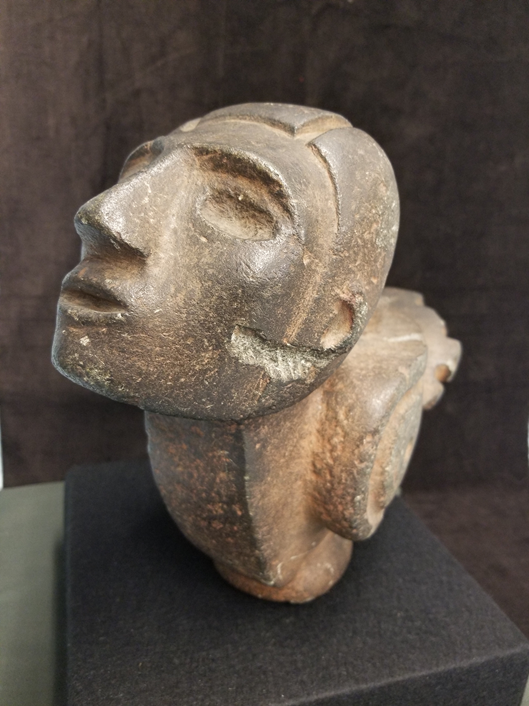By Amy L. Covell-Murthy
Accession Number 6395 is a large and unusual effigy pipe that was found in a field in Washington County, Pennsylvania. It was discovered first by the blade of a farmer’s plow. This pipe appears to be Adena, which refers to the mound building cultural group who occupied much of Ohio from approximately 1000-200 BC. Though there are a few Adena archaeological sites in Western Pennsylvania, the exact origin of this pipe is unknown.

Many archaeological sites in Pennsylvania are located under what we call, “plow zones.” As much of Pennsylvania was used as farmland, many archaeological sites have been disrupted vertically by the act of plowing. Native American cultural material close to the surface is often broken and scattered across the distance of the former fields. In the case of this object, it was found decades ago in an active plow zone. In the photographs below, you can see the “plow scar” on the cheek of the effigy where the plow gouged a large chunk out of the surface of the stone.
The Society for American Archaeology explains context as, “referring to the relationship that artifacts have to each other and the situation in which they are found. Every artifact found on an archaeological site has a precisely defined location. The exact spot where an artifact is found is recorded before it is removed from that location. When people remove an artifact without recording its precise location the context is lost forever and the artifact has little or no scientific value.” Since this pipewas found in a field and not in the context of an excavated site, we cannot say for sure where it originated. It may have been traded, or it may have been part of a larger site that was destroyed. There is no way of knowing how long it had been in the field. It could have been there for a hundred years or someone could have put it there a month before it was found.

This pipe is just one of the multitude of pieces in our massive Upper Ohio River Valley collection. Being able to provide space for academics to research things like this is one of the many highlights of my job. It is important to be able to provide scholars with the necessary material to finish their manuscripts, theses, and dissertations. These projects bring us closer to understanding how people lived in this region long before our time.

This artifact is featured in William Mayer-Oakes’s 1955 Carnegie Annals publication, Prehistory of the Upper Ohio Valley and has been photographed for Carnegie Magazine. It is also featured on the website for the Ohio History Connection. To learn more about the Society for American Archaeology visit www.saa.org.
Amy L. Covell-Murthy is the Archaeology Collection Manager at Carnegie Museum of Natural History. Museum employees are encouraged to blog about their unique experiences and knowledge gained from working at the museum.

